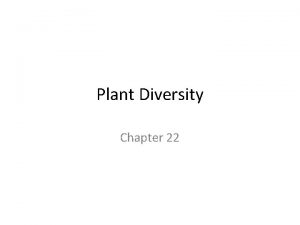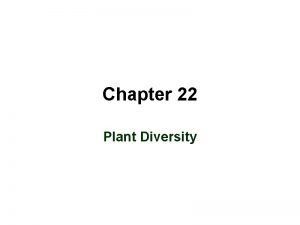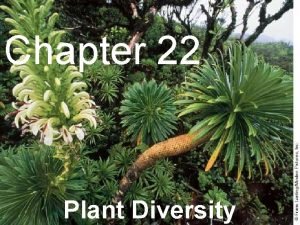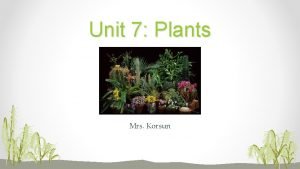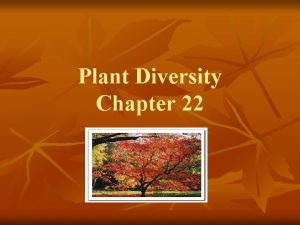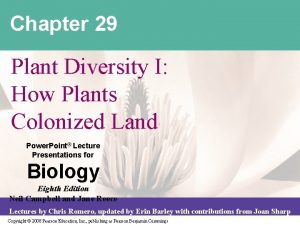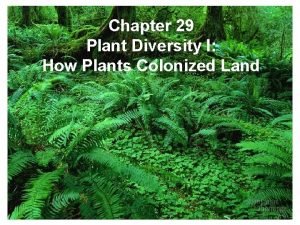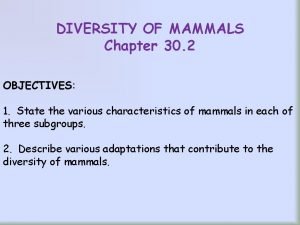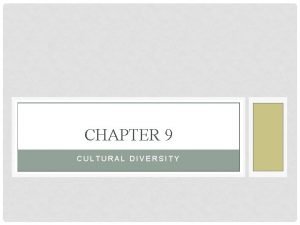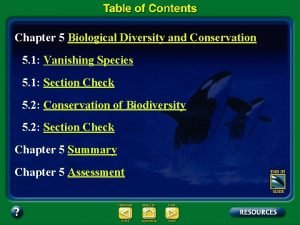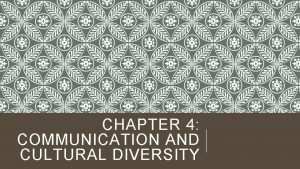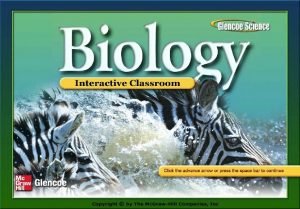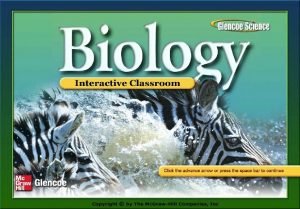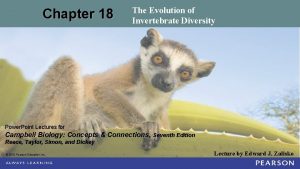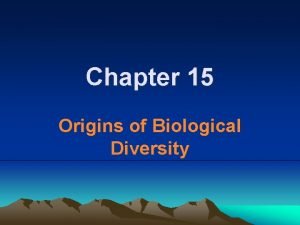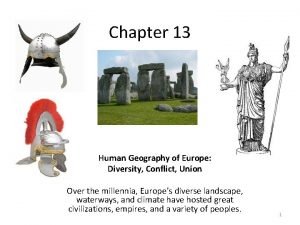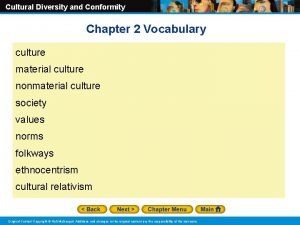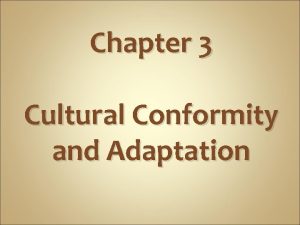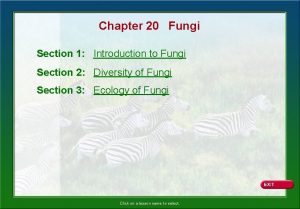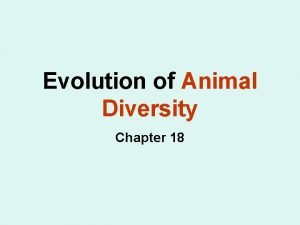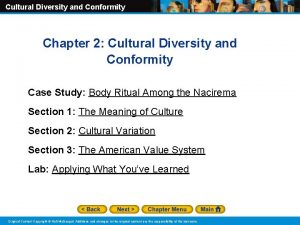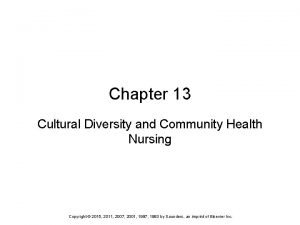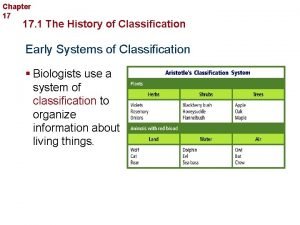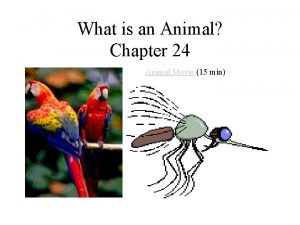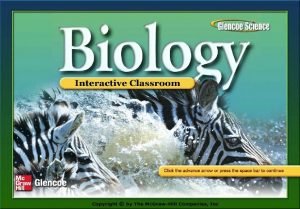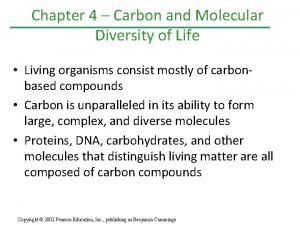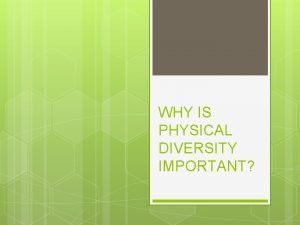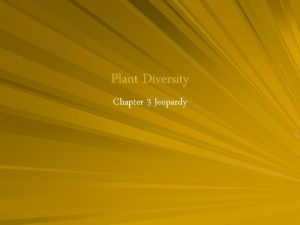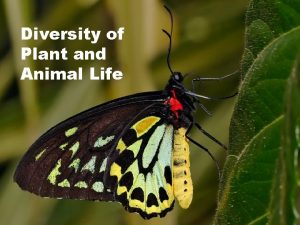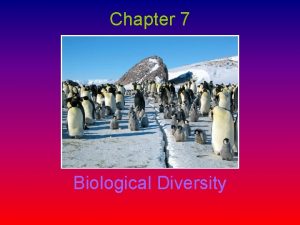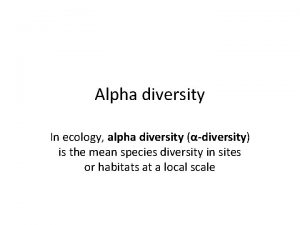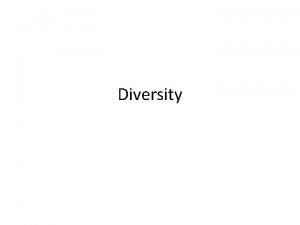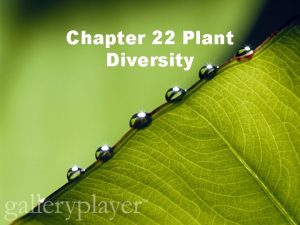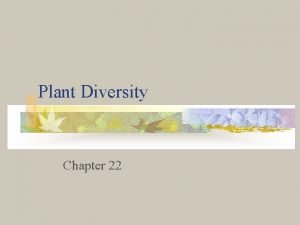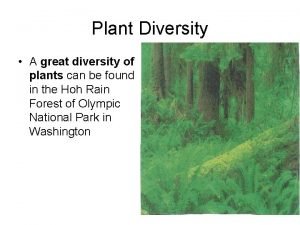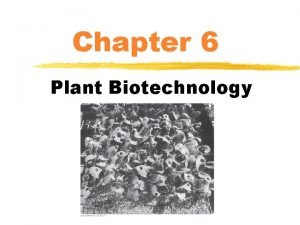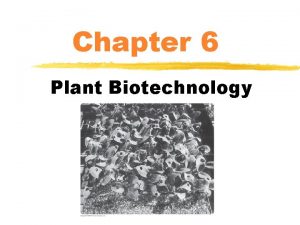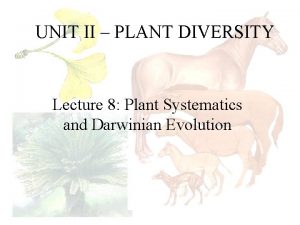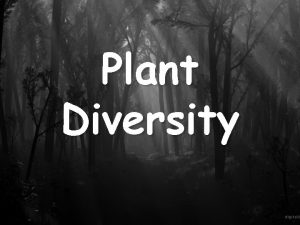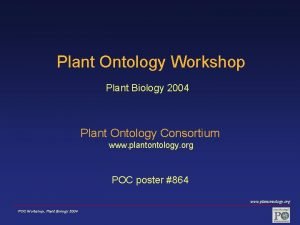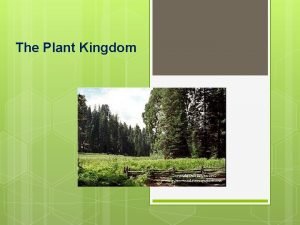Plant Diversity Chapter 22 What Is A Plant

















































- Slides: 49

Plant Diversity Chapter 22

What Is A Plant? • Multicellular eukaryotes • Cell walls made of cellulose • Multicellular embryos • Carry out photosynthesis using green pigments chlorophyll a and b • “Stationary animals that eat sunlight”

The Plant Life Cycle • Alternation of generations • Haploid gametophyte – Gamete-producing phase of an organism • Diploid sporophyte – Spore-producing phase of an organism • To be terrestrial, plants must be able to reproduce in dry environments where there is no water through which gametes can move from plant to plant

What Plants Need To Survive • Sunlight • Water and minerals • Gas exchange • Movement of water and nutrients

Early Plants • For most of Earth’s history plants did not exist • Life was concentrated in the oceans, lakes and streams • When plants appeared, much of the existing life on Earth changed • Green algae: the first plants evolved from an organism much like the multicellular green algae living today

The First Plants • Depended on water to complete their life cycles • Life on land favored the evolution of plants: – More resistant to the drying rays of the sun – More capable at conserving water – More capable of reproducing on dry land

The First Plants • Like today’s mosses: simple in structure and close to the ground • Gave rise to the different lineages of plants we have today!

Overview of the Plant Kingdom • Bryophytes • Seedless Vascular Plants • Gymnosperms • Angiosperms

Overview of the Plant Kingdom • Four groups based on: – Water-conducting tissues – Seeds – Flowers • Today scientists can classify plants more precisely by comparing DNA sequences of various species

BRYOPHYTES

Bryophytes • Mosses, liverworts and hornworts

Bryophytes • Life cycle depends on water for reproduction • Sperm swim through water to reach eggs of other plants • Lack vascular tissue • Can draw up water by osmosis only a few cm above the ground

Mosses • The most common bryophytes • Grow most abundantly in areas with water-swamps and bogs, near streams and in rainforests • Well adapted to wet habitats and nutrient-poor soils • Can tolerate low temperatures…they are the most abundant plants in polar regions

Mosses • Moss plants you see are gametophytes growing close together • When mosses reproduce, they produce thin stalks with a sporophyte • They do not have true roots; they have rhizoids • Rhizoids: long, thin cells that anchor them in the ground absorb water and minerals from the surrounding soil

Liverworts • Look like flat leaves attached to the ground • Some resemble the shape of a liver • Gametophyte stage: broad and thin structures that draw up moisture from the surface of the soil • Mature gametophyte stage: produces “umbrellas” that carry the structures to produce eggs and sperm

Liverworts • Sexual reproduction by means of gemmae • Gemmae: small, multicellular sphere that contain haploid cells • Produced in cuplike structures called gemma cups • When washed out of the gemma, these cells divide by mitosis and produce a new individual

Hornworts • Generally found in soil that is damp nearly year round • Gametophyte looks like those of liverworts • The sporophyte looks like a tiny green horn

Life Cycle of Bryophytes • Gametophyte = Dominant • The gametophyte carries out most of the plant’s photosynthesis • Dependence on water • Sperm of the bryophyte must swim to an egg for fertilization to occur

Example: Life Cycle of a Moss • Protonema: mass of tangles green filaments formed when a moss spore lands in a moist place, germinates and grow • Rhizoids grow into the ground and shoot grow into the air • The shoots become the familiar green moss plants, the gametophyte stage of the life cycle

Life Cycle of A Moss • Gametes are formed in the tips of the gametophyte • Antheridia: male reproductive structure in which sperm are produced • Archegonia: female reproductive structure in which eggs are produced

Life Cycle of A Moss • Some species have both sperm and egg on the same plant; other do not • A diploid zygote results from fertilization • The zygote = the sporophyte • Grows out of the gametophyte and depends on it for water and nutrients

Human Use of Mosses • Sphagnum mosses are a group of mosses that thrive in the acidic water bogs • Dried sphagnum moss absorbs many times its own weight in water and acts as a natural sponge • In certain environments the dead remains of sphagnum accumulate to form thick deposits of peat

Human Use of Mosses • Peat can be cut from the ground and burned as fuel • Peat moss has low p. H and increases soil acidity • Azaleas grow well only if planted in acidic soil

SEEDLESS VASCULAR PLANTS

Seedless Vascular Plants • Club mosses, horsetails, and ferns • Vascular tissue: a type of tissue that is specialized to conduct water and nutrients through the body of the plant • Tracheid: hollow plant cell in xylem tissue with thick cell walls that resist pressure

Seedless Vascular Plants • The xylem and phloem can move fluids throughout the plant body, even against the force of gravity • Lignin: substance made by vascular plants that makes cell walls rigid • Allows vascular plants to grow upright and reach great heights

Structure of Xylem: vascular tissue that carries water upward from the roots to every part of the plant

Structure of Phloem: vascular tissue responsible for the transport of nutrients and the carbohydrates produced by photosynthesis

Seedless Vascular Plants • Roots: absorb water and minerals • Leaves: photosynthetic organisms that contain one or more bundles of vascular tissue • Stems: supporting structures that connect roots and leaves, carrying water and nutrients between them

Club Mosses • Once ancient club mosses grew into huge trees-up to 35 meters tall • Some produced the Earth’s first forests • Today club mosses are small plants • Live in moist woodlands and near streambeds and marshes • “Ground Pine” …some look like miniature pine trees

Horsetails • True leaves, stems and roots • Leaves arranged in whorls at joints along the stem • Stem looks similar to horses’ tails • Stem contains crystals of abrasive silica • Horsetails were commonly used to scour pots and pans during Colonial times

Ferns • Probably evolved about 350 mya when great club moss forests covered the ancient Earth • Ferns have survived Earth’s long history in numbers greater than any other group of sporebearing vascular plants • More than 11, 000 species live today

Ferns • Have truly vascular tissues • Strong roots • Rhizomes: creeping or underground stems • Fronds: large leaves • Can thrive in areas with little light • Most abundant in wet or seasonably wet habitats

Example: Life Cycle of Ferns • Sporophyte = Dominant • Fern sporophytes produce haploid spores on the underside of their fronds in sporangia • Spores released from sporangia may be carried by wind and water over long distances

Life Cycle of Ferns • When the spores germinate they develop into haploid gametophytes • The diploid zygote is produced from fertilization • This sporophyte grows and the gametophyte withers away • Sporophytes often live for many years

SEED PLANTS

Seed Plants • Seeds include: – Acorns, pine nuts, dandelion seeds, kernels of corn, etc. • Seed plants are divided into two groups: – Gymnosperms – Angiosperms

Seed Plants • Reproduction free from water • As a result, seed plants can live just about anywhere • Adaptations to reproduce without water: – Flowers or cones – Transfer of sperm by pollination – Protection of embryos in seeds

Cones and Flowers • Gametophyte of seed plants grow and mature within sporophyte structures called cones (gymnosperms) and flowers (angiosperms)

Pollen • The entire male gametophyte is contained in a tiny structure called a pollen grain • The wind, insects, birds and small mammals may carries pollen grains • Pollination: the transfer of the pollen grain to the female gametophyte

Seeds • Embryo of a plant encased in a protective covering and surrounded by a food supply

Evolution of Seed Plants • The seed was very important evolutionarily • Mosses and ferns underwent major adaptive radiation 300 -400 mya • Land environments were much wetter than they are today

Evolution of Seed Plants • As the land became drier, it became harder for seedless plants to survive • Fossils of seed-bearing plants exist from almost 360 mya • The original seed plants resembled ferns

GYMNOSPERMS… CONE BEARERS

Gymnosperms…Cone Bearers • The most ancient surviving seed plants • Include gnetophytes, cycads, ginkgoes, and conifers • “Naked Seed”: these plants all reproduce with seeds that are exposed

Gymnosperms…Cone Bearers • Gnetophytes • Cycads • Ginkgoes • Conifers

Gnetophytes • The reproductive scales are clustered into cones • 70 present-day species are known

Cycads • Palm-like plants that reproduce with large cones • First appeared during the Triassic Period, 225 mya • Huge forests of cycads thrived when the dinosaurs roamed Earth • Only nine genera exist today

Ginkgoes • Were common when dinosaurs were alive • Today there is only one species, Ginkgo biloba • May be one of the oldest seed plant species alive today • Ginkgo trees were carefully cultivated in China where they were planted around temples • They are tough and resistant to air pollution-thus they are popular shade trees
 Why is genetic diversity important
Why is genetic diversity important Ecosystem jigsaw activity
Ecosystem jigsaw activity Chapter 22 plant diversity answer key
Chapter 22 plant diversity answer key Chapter 22 plant diversity answer key
Chapter 22 plant diversity answer key Chapter 22 plant diversity answer key
Chapter 22 plant diversity answer key Chapter 20 plant diversity
Chapter 20 plant diversity Gnetophyte
Gnetophyte Life cycle of seedless plants
Life cycle of seedless plants Chapter 29 plant diversity
Chapter 29 plant diversity Chapter 30 section 2 diversity of mammals
Chapter 30 section 2 diversity of mammals Chapter 9 cultural diversity
Chapter 9 cultural diversity Chapter 8 human resources culture and diversity
Chapter 8 human resources culture and diversity Chapter 8 study guide human resources culture and diversity
Chapter 8 study guide human resources culture and diversity Chapter 5 diversity and human needs and development
Chapter 5 diversity and human needs and development Chapter 5 biological diversity and conservation
Chapter 5 biological diversity and conservation Chapter 4 communication and cultural diversity
Chapter 4 communication and cultural diversity Characteristics of mammals
Characteristics of mammals General characteristics of arthropods
General characteristics of arthropods Chapter 18 the evolution of invertebrate diversity
Chapter 18 the evolution of invertebrate diversity Chapter 15 origins of biological diversity answers
Chapter 15 origins of biological diversity answers Chapter 13 diversity conflict union
Chapter 13 diversity conflict union Chapter 10 cultural diversity
Chapter 10 cultural diversity Cultural diversity and conformity section 2
Cultural diversity and conformity section 2 Cultural diversity and conformity chapter test form a
Cultural diversity and conformity chapter test form a Chapter 20 section 2 diversity of fungi
Chapter 20 section 2 diversity of fungi Animal diversity chapter
Animal diversity chapter Cultural diversity and conformity
Cultural diversity and conformity Chapter 4 growth diversity and conflict
Chapter 4 growth diversity and conflict Chapter 4 growth diversity and conflict
Chapter 4 growth diversity and conflict Chapter 13 cultural diversity and community health nursing
Chapter 13 cultural diversity and community health nursing Government chapter 21 diversity and discrimination
Government chapter 21 diversity and discrimination Organizing life's diversity
Organizing life's diversity Cultural diversity 3939 answers
Cultural diversity 3939 answers Tiburonia granrojo
Tiburonia granrojo Chapter 32 an overview of animal diversity
Chapter 32 an overview of animal diversity Chapter 13 diversity and difference in health care
Chapter 13 diversity and difference in health care Chapter 5 biological diversity and conservation
Chapter 5 biological diversity and conservation Chapter 4 carbon and the molecular diversity of life
Chapter 4 carbon and the molecular diversity of life Introduction in plant breeding
Introduction in plant breeding Taichum
Taichum Plant introduction in plant breeding
Plant introduction in plant breeding Tronsmo plant pathology and plant diseases download
Tronsmo plant pathology and plant diseases download Tronsmo plant pathology and plant diseases download
Tronsmo plant pathology and plant diseases download Tronsmo plant pathology and plant diseases download
Tronsmo plant pathology and plant diseases download Diversity refers to:
Diversity refers to: Diversity conclusion
Diversity conclusion Workplace diversity report example
Workplace diversity report example Meaning of physical diversity
Meaning of physical diversity Diversity wheel
Diversity wheel Ole miss diversity
Ole miss diversity


